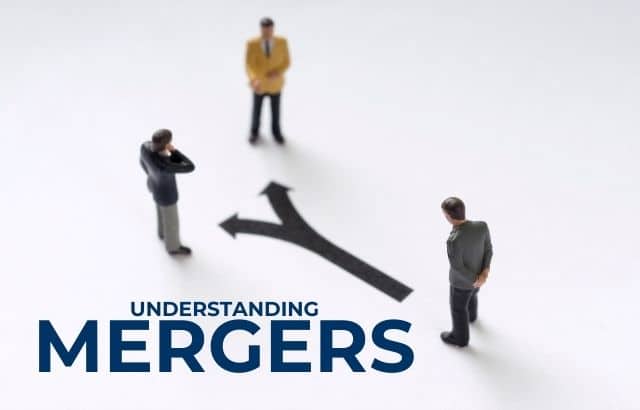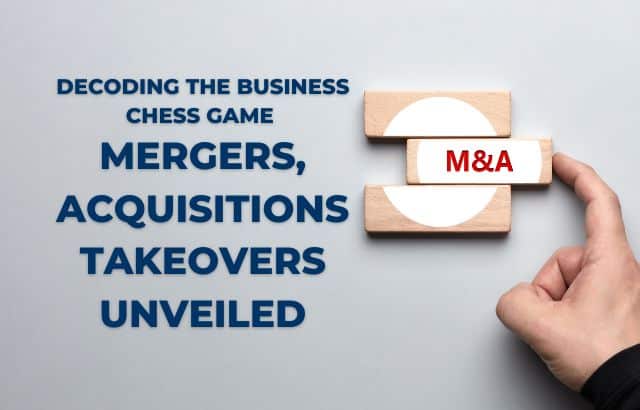Hey Entrepreneurs! Ever felt like the business world is playing chess, with everyone moving their pieces around the board? Welcome to the game of Mergers, Acquisitions, and Takeovers—a strategic dance where companies make power moves to level up. Let’s unravel the mysteries and demystify the buzzwords in a way that speaks your entrepreneurial language.
Table of Contents
The ABCs: Mergers, Acquisitions, and Takeovers

Mergers and Acquisitions Guide- What are Mergers?
In the world of business, a merger occurs when two companies decide to join forces and become one. It’s like a superhero team-up for businesses. A classic example is the merger between Disney and Pixar, where both companies combined their strengths to create innovative animated films, ultimately leading to greater success than either could achieve alone.
Mergers and Acquisitions Guide- What is an Acquisition?
An acquisition happens when one company buys another, either by purchasing a significant stake or acquiring full control. For instance, when Facebook acquired Instagram in 2012 for about $1 billion, it not only expanded its portfolio but also eliminated a competitor that could potentially threaten its social media dominance.
What are Takeovers?
Takeovers can be seen as the bold moves in chess—strategic maneuvers to seize control of another company. An example is the hostile takeover of Time Warner by AOL in 2000, which, while initially seen as a power move, ultimately became one of the most talked-about mergers due to its negative consequences.
Mergers and Acquisitions GuideWhy Play the Game?
Why do companies engage in this chess game? It’s all about growth! Mergers, acquisitions, and takeovers are power plays entrepreneurs use to expand their territories, access new markets, or eliminate competitors. Think of it as unlocking new levels in the business game—gaining resources, expertise, and customer bases that propel growth.
The Dance of Due Diligence
Before making any moves, entrepreneurs must perform a little dance called due diligence. This process ensures both parties know what they’re getting into—analyzing everything from financial health to cultural compatibility. Imagine it as a first date with spreadsheets and legal documents; you want to avoid surprises after saying “I do” in the business world!
Mergers and Acquisitions Guide -Roles of a Business Strategist

A business strategist plays a vital role in navigating these waters. They assess market conditions, evaluate potential targets for acquisition, and help devise integration plans post-merger. Their insights guide companies in making informed decisions that align with long-term goals. For example, a strategist might analyze a competitor’s strengths and weaknesses to determine if a merger would enhance market position or create efficiencies.
Friendly Mergers vs. Hostile Takeovers
Not all mergers are created equal. Some are friendly gatherings—think of them as family reunions where everyone’s on board and happy. For instance, the merger between Kraft and Heinz was a friendly alliance aimed at consolidating market power.
On the other hand, hostile takeovers are the unexpected plot twists. These occur when a company swoops in uninvited, aiming to take control against the wishes of the target’s management. A notable example is the attempted takeover of Unocal by Chevron, which faced resistance from Unocal’s board, leading to a high-stakes battle.
The Impact on Entrepreneurs
So, why should you, the entrepreneur, care about this business ballet? Because it affects you! A well-timed merger can open new opportunities for collaboration and innovation. For instance, if two companies in your sector merge, it could lead to new standards or practices that you’ll need to adapt to.
Conversely, if a competitor is acquired or merges, it could shift the playing field dramatically. Stay vigilant, be adaptable, and who knows? You might find your business at the center of the next strategic move.
Mergers and Acquisitions Guide -Calculating the Potential Impact of Mergers
Let’s look at some numbers to illustrate the financial impact of a merger:
- Company A’s Annual Revenue: $5 million
- Company B’s Annual Revenue: $3 million
- Projected Cost Synergies Post-Merger: $1 million
Total Projected Revenue Post-Merger:
5 million+3 million+1 million (synergies)=9 million5 \text{ million} + 3 \text{ million} + 1 \text{ million (synergies)} = 9 \text{ million}
By merging, the combined company could see a revenue increase from $8 million to $9 million, showcasing the potential financial benefits of strategic alliances.
Mergers and Acquisitions Guide -FAQs about Mergers, Acquisitions, and Takeovers

Q: What is the difference between a merger and an acquisition?
A: A merger involves two companies joining forces to become one, while an acquisition is when one company buys another. Mergers are often more collaborative, whereas acquisitions can be more unilateral.
Q: Why do companies choose to merge or acquire?
A: Companies merge or acquire to achieve growth, enter new markets, gain competitive advantages, enhance efficiencies, or access new technologies.
Q: How does due diligence work?
A: Due diligence involves thorough investigations of a company’s financials, operations, and legal standing to ensure the acquiring company fully understands what it is buying.
Q: Can a merger fail?
A: Yes, many mergers fail due to cultural clashes, poor integration, or lack of strategic alignment. For example, the merger between AOL and Time Warner faced significant challenges and is often cited as a failure.
Q: What role do business strategists play during a merger or acquisition?
A: Business strategists help assess potential targets, develop negotiation strategies, and create integration plans to ensure successful mergers and acquisitions align with the company’s overall strategy.
Mergers and Acquisitions Guide
So, fellow entrepreneurs, now that we’ve demystified the world of mergers, acquisitions, and takeovers, how will you navigate the business chessboard? Will you be the grandmaster making strategic moves, or the knight charging forward fearlessly? The game is on, and it’s your move! Stay informed, adaptable, and ready to seize opportunities as they arise.










